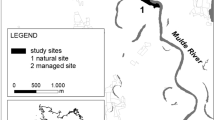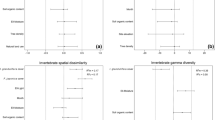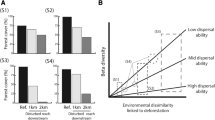Abstract
While anthropogenic biodiversity loss in fresh waters is among the most rapid of all ecosystems, impacts on the conservation of associated riparian zones are less well documented. Riverine ecotones are particularly vulnerable to the combined ‘squeeze’ between land-use encroachment, discharge regulation and climate change. Over a 3-year period of persistent low discharge in a regulated, temperate river system (River Usk, Wales, UK; 2009–2011), specialist carabid beetles on exposed riverine sediments (ERS) were used as model organisms to test the hypotheses that catchment-scale flow modification affects riparian zone invertebrates more than local habitat character, and that this modification is accompanied by associated succession among the Carabidae. Annual summer discharge during the study period was among the lowest of the preceding 12 years, affecting carabid assemblages. The richness of specialist ERS carabids declined, while generalist carabid species’ populations either increased in abundance or remained stable. Community composition also changed, as three (Bembidion prasinum, B. decorum and B. punctulatum) of the four dominant carabids typical of ERS increased in abundance while B. atrocaeruleum decreased. Despite significant inter-annual variation in habitat quality and the encroachment of ground vegetation, beetle assemblages more closely tracked reach-scale variations between sites or catchment-scale variations through time. These data from multiple sites and years illustrate how ERS Carabidae respond to broad-scale discharge variations more than local habitat character. This implies that the maintenance of naturally variable flow regimes is at least as important to the conservation of ERS and their dependent assemblages as are site-scale measures.








Similar content being viewed by others
References
Akaike H (1974) A new look at the statistical model identification. IEEE Trans Autom Control AC19:716–723
Alaruikka D, Kotze DJ, Matveinen K, Niemela J (2002) Carabid beetle and spider assemblages along a forested urban–rural gradient in southern Finland. J Insect Conserv 6:195–206
Amoros C, Bornette G (2002) Connectivity and biocomplexity in waterbodies of riverine floodplains. Freshw Biol 47:761–776
Andersen J (1968) The effect of inundation and choice of hibernation sites of Coleoptera living on river banks. Nor Entomol Tidsskr 15:115–133
Andersen J (1989) Photoresponse of carabid beetles depends on experimental design. Oikos 54:195–200
Andersen J (2011) Hibernation sites of riparian ground beetles (Coleoptera, Carabidae) in Central and Northern Norway. Nor J Entomol 58:111–121
Baiocchi S, Fattorini S, Bonavita P, Taglianti AV (2012) Patterns of beta diversity in riparian ground beetle assemblages (Coleoptera Carabidae): a case study in the River Aniene (Central Italy). Ital J Zool 79:136–150
Ballinger A, Lake PS (2006) Energy and nutrient fluxes from rivers and streams into terrestrial food webs. Mar Freshw Res 57:15–28
Bates A, Sadler JP (2005) The ecology and conservation of beetles associated with exposed riverine sediments. Countryside Council for Wales, Contract Science Report No. 688
Bates A, Sadler JP, Fowles AP, Butcher CR (2005) Spatial dynamics of beetles living on exposed riverine sediments in the upper River Severn: method development and preliminary results. Aquat Conserv Marine Freshw Ecosyst 15:159–174
Bates AJ, Sadler JP, Fowles AP (2006) Condition-dependent dispersal of a patchily distributed riparian ground beetle in response to disturbance. Oecologia 150:50–60
Bates AJ, Sadler JP, Fowles AP (2007a) Livestock trampling reduces the conservation value of beetle communities on high quality exposed riverine sediments. Biodivers Conserv 16:1491–1509
Bates AJ, Sadler JP, Perry JN, Fowles AP (2007b) The microspatial distribution of beetles (Coleoptera) on exposed riverine sediments (ERS). Eur J Entomol 104:479–487
Bates AJ, Sadler JP, Henshall SE, Hannah DM (2009) Ecology and conservation of arthropods of exposed riverine sediments (ERS). Terr Arthropod Rev 2:77–98
Bouchard P, Goulet H, Wheeler TA (1998) Phenology and habitat preferences of three species of ground beetles (Coleoptera: Carabidae) associated with alvar habitats in southern Ontario. Proc Entomol Soc Ontario 129:19–29
Braun SD, Jones TH, Perner J (2004) Shifting average body size during regeneration after pollution—a case study using ground beetle assemblages. Ecol Entomol 29:543–554
Buchholz S, Hannig K, Schirmel J (2013) Losing uniqueness—shifts in carabid species composition during dry grassland and heathland succession. Anim Conserv 16:661–670
Capon SJ, Chambers LE, Mac Nally R, Naiman RJ, Davies P, Marshall N, Pittock J et al (2013) Riparian ecosystems in the 21st century: hotspots for climate change adaptation? Ecosystems 16:359–381
Cardenas AM, Hidalgo JM (2007) Application of the mean individual biomass (MIB) of ground beetles (Coleoptera, Carabidae) to assess the recovery process of the Guadiamar Green Corridor (Southern Iberian Peninsula). Biodivers Conserv 16:4131–4146
Clews E, Vaughan IP, Ormerod SJ (2010) Evaluating the effects of riparian restoration on a temperate river-system using standardized habitat survey. Aquat Conserv Marine Freshw Ecosyst 20:S96–S104
Collier KJ, Bury S, Gibbs M (2002) A stable isotope study of linkages between stream and terrestrial food webs through spider predation. Freshw Biol 47:1651–1659
DCWW (2014) Final Water Resources Management Plan. Dŵr Cymru Welsh Water, Mid Glamorgan
del Camino Pelaez M, Salgado JM (2007) Ecology and biology of some species of Carabidae (Coleoptera) from the Sueve Massif (Asturias, Spain): phenology and annual fluctuation. Boletin de la S.E.A, pp 333–350
Desender K (1989) Heritability of wing development and body size in a carabid beetle, Pogonus-chalceus Marsham, and its evolutionary significance. Oecologia 78:513–520
EAW (2007) River Usk Catchment Management Abstraction Strategy (Online). Environment Agency Wales. http://www.environment-agency.gov.uk/business/topics/water/119927.aspx. Accessed 8 Feb 2008
EAW (2008) River Quality Data River Usk. Environment Agency Wales
EAW (2009) Severn river basin district. River Basin Management Plans. Environment Agency Wales
EC (1992) Council Directive 92/43/EEC May 19 1992 on the conservation of habitats and of wild fauna and flora
Eyre MD, Luff ML (2002) The use of ground beetles (Coleoptera: Carabidae) in conservation assessments of exposed riverine sediment habitats in Scotland and northern England. J Insect Conserv 6:25–38
Fowles AP (2004) Specialist Coleoptera of Exposed Riverine Sediments (ERS) (Online). http://yrefail.net/Coleoptera/ersqi.htm. Accessed 8 May 2009
Gauch HG (1982) Multivariate analysis in community ecology. Cambridge University Press, Cambridge
Gergely A, Hahn I, Meszaros-Draskovits R, Simon T, Szabo M, Barabas S (2001) Vegetation succession in a newly exposed Danube riverbed. Appl Veg Sci 4:35–40
Gerisch M (2011) Habitat disturbance and hydrological parameters determine the body size and reproductive strategy of alluvial ground beetles. Zookeys 100:353–370
Gerisch M, Agostinelli V, Henle K, Dziock F (2012) More species, but all do the same: contrasting effects of flood disturbance on ground beetle functional and species diversity. Oikos 121:508–515
Gray JS (1989) Effects of environmental-stress on species rich assemblages. Biol J Linn Soc 37:19–32
Greenwood MJ, McIntosh AR (2010) Low river flow alters the biomass and population structure of a riparian predatory invertebrate. Freshw Biol 55:2062–2076
Henshall SE, Sadler JP, Hannah DM, Bates AJ (2011) The role of microhabitat and food availability in determining riparian invertebrate distributions on gravel bars: a habitat manipulation experiment. Ecohydrology 4:512–519
Jaskula R, Soszynska-Maj A (2011) What do we know about winter active ground beetles (Coleoptera, Carabidae) in Central and Northern Europe? Zookeys 100:517–532
Jelaska LS, Dumbovic V, Kucinic M (2011) Carabid beetle diversity and mean individual biomass in beech forests of various ages. Zookeys 100:393–405
Jonsson M, Deleu P, Malmqvist B (2013) Persisting effects of river regulation on emergent aquatic insects and terrestrial invertebrates in upland forests. River Res Appl 29:537–547
Kivimagi I, Ploomi A, Metspalu L, Svilponis E, Jogar K, Hiiesaar K, Luik A et al (2009) Overwintering physiology of a carabid beetle Platynus assimilis. Agron Res 7(Special Issue I):328–334
Kleinwaechter M, Rickfelder T (2007) Habitat models for a riparian carabid beetle: their validity and applicability in the evaluation of river bank management. Biodivers Conserv 16:3067–3081
Kotze DJ, Niemela J, O’Hara RB, Turin H (2003) Testing abundance-range size relationships in European carabid beetles (Coleoptera, Carabidae). Ecography 26:553–566
Kwiatkowski A (2011) Assemblages of carabid beetles (Coleoptera, Carabidae) in humid forest habitats of different stages of succession in the Puszcza Knyszynska Forest (northeastern Poland). Zookeys 100:447–459
Lambeets K, Hendrickx F, Vanacker S, Van Looy K, Maelfait JP, Bonte D (2008) Assemblage structure and conservation value of spiders and carabid beetles from restored lowland river banks. Biodivers Conserv 17:3133–3148
Larsen S, Vaughan IP, Ormerod SJ (2009) Scale-dependent effects of fine sediments on temperate headwater invertebrates. Freshw Biol 54:203–219
Luff ML (ed) (2005) Biology and ecology of immature stages of ground beetles (Carabidae). European Carabidology 2003. Danish Institute of Agricultural Sciences, Arhus. Dias Report Plant Production 114
Luff ML (2007) The Carabidae (ground beetles) of Britain and Ireland, 2nd edn. Royal Entomological Society, London
Manderbach R, Hering D (2001) Typology of riparian ground beetle communities (Coleoptera, Carabidae, Bembidion spec.) in Central Europe and adjacent areas. Arch Hydrobiol 152:583–608
Mantyka-Pringle CS, Martin TG, Moffatt DB, Linke S, Rhodes JR (2014) Understanding and predicting the combined effects of climate change and land-use change on freshwater macroinvertebrates and fish. J Appl Ecol 51:572–581
McCluney KE, Sabo JL (2012) River drying lowers the diversity and alters the composition of an assemblage of desert riparian arthropods. Freshw Biol 57:91–103
Noordhuis R, Thomas SR, Goulson D (2001) Overwintering populations of beetle larvae (Coleoptera) in cereal fields and their contribution to adult populations in the spring. Pedobiologia 45:84–95
O’Callaghan MJ, Hannah DM, Williams M, Sadler JP (2013) Exposed riverine sediments (ERS) in England and Wales: distribution, controls and management. Aquat Conserv Marine Freshw Ecosyst 23:924–938
Ormerod SJ (2004) A golden age of river restoration science? Aquat Conserv Marine Freshw Ecosyst 14:543–549
Paetzold A, Schubert CJ, Tockner K (2005) Aquatic terrestrial linkages along a braided-river: riparian arthropods feeding on aquatic insects. Ecosystems 8:748–759
Paetzold A, Yoshimura C, Tockner K (2008) Riparian arthropod responses to flow regulation and river channelization. J Appl Ecol 45:894–903
Rolls RJ, Leigh C, Sheldon F (2012) Mechanistic effects of low-flow hydrology on riverine ecosystems: ecological principles and consequences of alteration. Freshw Sci 31:1163–1186
Sadler J, Bell D (2000) A comparative site assessment of exposed riverine sediment (ERS) beetle faunas in south-west England. Engl Nat Res Rep 383:1–90
Sadler JP, Bell D, Fowles A (2004) The hydroecological controls and conservation value of beetles on exposed riverine sediments in England and Wales. Biol Conserv 118:41–56
Sadler JP, Bell D, Bates A (2006) The abundance and dynamics of Coleoptera populations on exposed riverine sediments on the River Severn in Wales. CCW Contract Science Report No. 754. Countryside Council for Wales, Bangor
Saska P, Honek A (2003) Temperature and development of central European species of Amara (Coleoptera: Carabidae). Eur J Entomol 100:509–515
Schwerk A, Szyszko J (2007) Increase of mean individual biomass (MIB) of Carabidae (Coleoptera) in relation to succession in forest habitats. Wiad Entomol 26:195–206
Schwerk A, Salek P, Duszczyk M, Abs M, Szyszko J (2006) Variability of Carabidae in time and space in open areas. Entomol Fenn 17:258–268
Sinnadurai P (2014) The ecology of riparian Carabidae (Coleoptera) in a regulated river system. PhD Thesis, Cardiff University
Strayer DL, Dudgeon D (2010) Freshwater biodiversity conservation: recent progress and future challenges. J N Am Benthol Soc 29(1):344–358
Strayer DL, Findlay SEG (2010) Ecology of freshwater shore zones. Aquat Sci 72:127–163
Tockner K, Pusch M, Borchardt D, Lorang MS (2010) Multiple stressors in coupled river-floodplain ecosystems. Freshw Biol 55:135–151
Traugott M (1998) Larval and adult species composition, phenology and life cycles of carabid beetles (Coleoptera: Carabidae) in an organic potato field. Eur J Soil Biol 34:189–197
Ulrich W, Komosinski K, Zalewski M (2008) Body size and biomass distributions of carrion visiting beetles: do cities host smaller species? Ecol Res 23:241–248
Van Looy K, Vanacker S, Jochems H, De Blust G, Dufrene M (2005) Ground beetle habitat templates and riverbank integrity. River Res Appl 21:1133–1146
Van Looy K, Jochems H, Vanacker S, Lommelen E (2007) Hydropeaking impact on a riparian ground beetle community. River Res Appl 23:223–233
Zhang JX, Drummond FA, Liebman M, Hartke A (1997) Phenology and dispersal of Harpalus rufipes DeGeer (Coleoptera: Carabidae) in agroecosystems in Maine. J Agric Entomol 14:171–186
Acknowledgments
The landowners Chris Alford, Helen and Richard Roderick, Geoff Williams and Sue Williams gave permission for fieldwork. Brian Levy, National Museum of Wales, provided assistance with beetle identification. The Brecon Beacons National Park Authority supported all research. Insightful and helpful comments were provided by two anonymous reviewers.
Author information
Authors and Affiliations
Corresponding author
Additional information
Communicated by Mark James Kennard.
Electronic supplementary material
Below is the link to the electronic supplementary material.
Rights and permissions
About this article
Cite this article
Sinnadurai, P., Jones, T.H. & Ormerod, S.J. Squeezed out: the consequences of riparian zone modification for specialist invertebrates. Biodivers Conserv 25, 3075–3092 (2016). https://doi.org/10.1007/s10531-016-1220-9
Received:
Revised:
Accepted:
Published:
Issue Date:
DOI: https://doi.org/10.1007/s10531-016-1220-9




